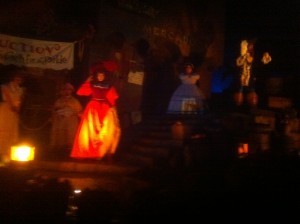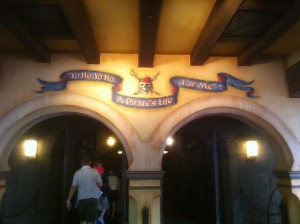Review: Pirates of the Caribbean at the Magic Kingdom
By Dave Shute
 PIRATES OF THE CARIBBEAN
PIRATES OF THE CARIBBEAN
Long-time readers will know that I review rides only when they are new or after they have changed, on the theory that first-time visitors ought to try them all and hence don’t need reviews.
(For those without the time or energy to try them all, there’s a
comprehensive guide to Disney World rides and attractions and also a list of Disney World rides that might be skipped.)
Well, the venerable Pirates of the Caribbean ride at the Magic Kingdom had a recent change–Blackbeard was added to one of the ride elements! Not a big deal, but enough of an excuse for me to ride it again and publish a review!
Especially since minor changes at the Haunted Mansion and Splash Mountain also give me reasons for reviews of them, and these three rides are best thought of as variations on a theme–the theme being the picaresque.
PIRATES OF THE CARIBBEAN AFTER THE MOST RECENT CHANGES
First things first: the change doesn’t affect the ranking of Pirates of the Caribbean as a “favorite” for older kids and adults and “other’ for little kids.
“Other” for little kids because, though the ride isn’t scary in total, there are lots of skeletons and a realistic fire scene.
The switch of one ride element to Blackbeard–a tie in to the latest movie–neither adds to nor detracts from the ride. The effect also does not depend on whether or not you have seen the latest movie–either way, it’s fun and ominous.
Pirates of the Caribbean was a landmark when it opened at Disneyland and remains an essential part of a visit to the Magic Kingdom.
At Disneyland, Pirates emerged from the confluence of three separate streams:
- The realization after the opening of the Tiki Birds at Disneyland, and of Great Moments with Mr. Lincoln at the New York World’s Fair, that audio-animatronics (Disney’s moving figures) could fully serve as the basis for an attraction
- The realization after the success of It’s a Small World at the same fair that a boat-based system could create a very high capacity ride–a “people eater,” in the parlance of the imagineers
- The shift of Marc Davis from Disney’s films to Disneyland
Of these, to me the most important point was Davis.
Marc Davis added a gift for gags–especially sight gags–that resulted in the enduring appeal of not only Pirates of the Caribbean, but also the Jungle Cruise (where he was responsible for adding many of the sillier elements–e.g. the “point”) and the Haunted Mansion.
Davis was also a gifted animator and one of Walt Disney’s most trusted “story men.” His ability to shape a gag, to design an environment, and to build a story, when combined with the talents of all the other key people on the Pirates team, led to the ride we have today.
Davis brought a particular perspective to “story” that shaped many rides that came after Pirates of the Caribbean.
Before Davis, Disneyland rides tended to either follow a movie’s plot (Peter Pan) or have no plot at all (the Teacups).
Davis recognized that an attraction could work as a series of related scenes that built to a climax even if there was little or no connective story that linked one scene necessarily to the next.
That is, a “story” did not have to have a “plot’–a logical and causal structure explaining why its events occur, and why they occur in the order that they do
It could instead be picaresque, simply the unfolding of related scenes building to a big finish.
This focus on scenes–richly detailed, thematically but not necessarily structurally linked, and often framed around a gag–shaped the next generation of Disney rides, and largely held until the Eisner era, when the focus on narrative became more important (think Dinosaur, which does have a plot).
Pirates of the Caribbean was a smash hit when it opened at Disneyland, and in the view of some “saved the park.”

Guest disappointment was so great that Pirates of the Caribbean was being built at the Magic Kingdom within a year of its opening.
Since then, the ride has had various changes and upgrades, one making the auction scene more politically correct (though less funny, and slightly incomprehensible–even in the early 60s Davis feared that this scene was “not Disney”), and another adding Captain Jack Sparrow after the success of the movies.
Since the addition of Sparrow, it has seen several minor upgrades, including the latest addition of Blackbeard.
Despite these changes, the bones of the ride were arranged almost 50 years ago, and it has stood the test of time remarkably well.
Other than possibly the technology behind the fire scene, little seems dated or hokey, the theme of pirates having fun and meeting their just or unjust desserts still works, and the beginning of the ride remains as haunting as ever!
(For more, see Jason Surrell’s Pirates of the Caribbean: From the Magic Kingdom to the Movies.)




0 comments
Comment by typing in the form below.
Leave a Comment | Ask a Question | Note a Problem